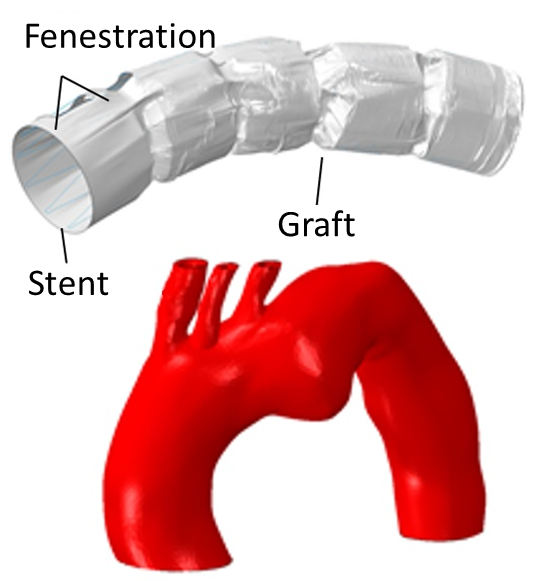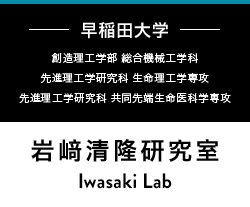Stent Graft Therapeutic Technology Group
Visualization of the false lumen in dissecting aortic aneurysms
 A stent graft used for chronic aortic dissection is a medical device designed to prevent rupture of the aneurysm by blocking blood flow through the tears between the true and false lumens and stagnating the flow in the false lumen to expect thrombus formation.
However, aortic dissection has multiple tears, and attempting to close all tears may interrupt the blood flow to essential branch vessels. If we can predict the extent to which the distal tear can be thrombosed after the proximal tear is closed with a stent graft, we can provide guidelines for clinical treatment.
In this study, we use particle image velocimetry (PIV) to visualize the blood flow in the false lumen to understand the effect of stent grafts on intravascular blood flow. We will also calculate the flow velocity distribution to elucidate where thrombosis can occur and the anatomical factors that affect the process.
A stent graft used for chronic aortic dissection is a medical device designed to prevent rupture of the aneurysm by blocking blood flow through the tears between the true and false lumens and stagnating the flow in the false lumen to expect thrombus formation.
However, aortic dissection has multiple tears, and attempting to close all tears may interrupt the blood flow to essential branch vessels. If we can predict the extent to which the distal tear can be thrombosed after the proximal tear is closed with a stent graft, we can provide guidelines for clinical treatment.
In this study, we use particle image velocimetry (PIV) to visualize the blood flow in the false lumen to understand the effect of stent grafts on intravascular blood flow. We will also calculate the flow velocity distribution to elucidate where thrombosis can occur and the anatomical factors that affect the process.
Morphological Assessment After Stent-Graft Implantation Using an Abdominal Aortic Aneurysm Model
 Stent-graft implantation for abdominal aortic aneurysms aims to prevent rupture by blocking blood flow into the aneurysm.
However, patients with aneurysms located near the renal artery are challenging to treat because of renal artery blood flow blockage. However, the factors that affect the blockage of blood flow to the aneurysm and the indices for evaluating them have not been established.
In this study, we are quantifying the adhesion characteristics of the stent-graft to the vessel wall, which is thought to affect the remaining blood flow path to the aneurysm.
Stent-graft implantation for abdominal aortic aneurysms aims to prevent rupture by blocking blood flow into the aneurysm.
However, patients with aneurysms located near the renal artery are challenging to treat because of renal artery blood flow blockage. However, the factors that affect the blockage of blood flow to the aneurysm and the indices for evaluating them have not been established.
In this study, we are quantifying the adhesion characteristics of the stent-graft to the vessel wall, which is thought to affect the remaining blood flow path to the aneurysm.
Prediction of Stent-Graft Implantation Morphology Using Finite Element Analysis
 The Najuta® stent-graft is the only device in Japan that can preserve blood flow in the head and neck branches to treat arch aortic aneurysms.
However, there is a risk that the stent may deform into the aneurysm under the influence of blood flow and blood pressure after implantation, causing a mismatch in the window for branch vessels. This is an important issue that can lead to endoleak, which is the residual blood flow in the aneurysm, and the main cause of stent deformation is still unknown.
This study aims to design an optimal implantation position and device that can suppress stent deformation by simulating the implantation process using finite element analysis (FEM) and predicting the implantation morphology using CAD models of stent-grafts and aortic aneurysms obtained from patient CT data.
The Najuta® stent-graft is the only device in Japan that can preserve blood flow in the head and neck branches to treat arch aortic aneurysms.
However, there is a risk that the stent may deform into the aneurysm under the influence of blood flow and blood pressure after implantation, causing a mismatch in the window for branch vessels. This is an important issue that can lead to endoleak, which is the residual blood flow in the aneurysm, and the main cause of stent deformation is still unknown.
This study aims to design an optimal implantation position and device that can suppress stent deformation by simulating the implantation process using finite element analysis (FEM) and predicting the implantation morphology using CAD models of stent-grafts and aortic aneurysms obtained from patient CT data.

